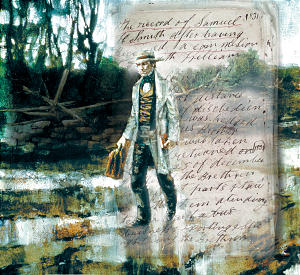Samuel Harrison Smith
Born March 13, 1808, in Tunbridge, Vermont, to Joseph Smith, Sr., and Lucy Mack Smith, Samuel had moved with his family to western New York by the 1820s. When Samuel's father missed a mortgage payment on the family farm on the outskirts of Manchester, New York, a local Quaker named Lemuel Durfee purchased the land and allowed the Smiths to continue to live there in exchange for Samuel's labor at Durfee's store.
At the end of June 1829, Samuel, along with his brother Hyrum, his father, and several men of the Peter Whitmer, Sr. family, signed a joint statement declaring their testimony of the Golden Plates. This "Testimony of the Eight Witnesses" was then printed as part of the Book of Mormon.
When the church was later organized on April 6, 1830, Samuel became one of the first six members. At the next Church conference, he was ordained one of the Church's earliest elders. He served a number of missions for the Church and was a very successful. When the first "High Council" of the church—at the time the chief judicial and legislative body—was organized on February 17, 1834, Samuel was one of twelve men called to be high counselors. Later that year, Samuel married Mary Bailey, his first wife, with whom he had four children.
Samuel moved with his family to Far West, Missouri, in 1838 and took part in the subsequent Mormon War that took place in northwestern Missouri that year. At the Battle of Crooked River, Samuel fought next to Apostle David W. Patten, who subsequently died from wounds received in the skirmish. As a result of the conflict, the Latter-day Saints were expelled from Missouri and Samuel moved with the main body to their new headquarters in Nauvoo, Illinois.
Samuel's wife Mary died in Nauvoo in 1841 and he married Lavira Clark later that year. Samuel and Lavira had three children together.
When Samuel's brothers, Joseph and Hyrum, were assassinated in 1844, some assumed that he would succeed them as Prophet and President of the Latter-day Saint church. Samuel died just one month later, however; possibly from being attacked from mobbers and then evading them as he traveled toward Carthage. He later helped retrieve his brothers' bodies, driving one of the wagons that carried them back to Nauvoo.[1] He fell ill shortly after. His death was attributed to "bilious fever," a generic diagnosis.
